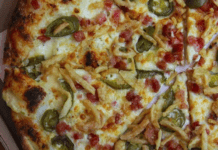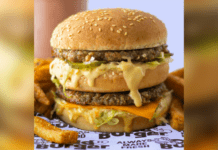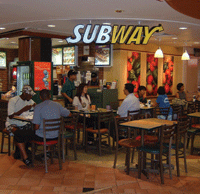The past year could be described as nothing short of spectacularly predictable, given the way it so reliably cleaved to expectations set out for it by economists. Overall, according to the Toronto-based Canadian Restaurant and Foodservice Association (CRFA), restaurant sales in this country are expected to grow by 4.4 per cent in 2013, bringing total industry sales to $54.9 billion. Speaking broadly, this is good news, but scratch the surface and you’ll discover a year that is a mixed bag for an industry still very much in the throes of economic recovery.
As might be expected, quick-service restaurants are the typical beneficiaries of a flagging economic climate. It stands to reason the more high-end the foodservice establishment, the less likely it’s going to flourish when consumers don’t have a lot of disposal money to spend on eating out. That’s been the scenario now for a few years as QSR has lead the pack in 2010, 2011 and 2012, nudging full-service out of its long-standing post as the biggest segment in the restaurant industry. For 2013, with full-service creeping back into market-share prominence, there’s a rare statistical tie between the two. Quick-service restaurant sales should hit about $23.9 billion this year — almost exactly the same size as the full-service market. That, says the CRFA’s senior economist Chris Elliott, “is the big story for 2013 restaurant sales.”
QSR: Subway
When Subway launched in 1965, a mere handful of companies existed in its segment. Today, there are 54 submarine sandwich chains in North America, and every one of them is trying — as chief development officer for Subway’s franchise world headquarters Don Fertman puts it — to “eat our lunch.”
There’s no silver bullet to Subway’s enduring record of success, says Fertman. It’s a simple business model; there’s neither grilling nor frying nor a huge army of employees to oversee. The low investment lends itself to multi-unit ownership (multiple-location franchisees account for 80 per cent of Subway’s stores). And, the franchise’s flexible footprint means it can go into locations like the World Trade Center site or the riverboat on the Rhine without a call for massive modification. That helps to explain the company’s 164-consecutive-month run of positive store growth. It added more than 1,600 locations outside the U.S. last year — more than any other brand — and more than 800 stateside. This year, it’s already opened more than 2,000 stores worldwide, and the chain, with 40,300-plus units, is on track to hit 45,000 stores by the end of 2015.
Subway’s strategy focuses on three key tenets: great product, excellent service and good value. Regarding the former, Subway execs have the bases covered with a selection of sandwiches and salads that runs the gamut from the low-fat and good-for-you to the super-indulgent and sauce-and-cheese-smothered.
Regarding service, Subway’s practice of customization grants retailers an opportunity to interact with customers while preparing their unique sandwiches — instead of simply handing them something made earlier in the back. “If we can make that face time a great experience for the customer,” says Fertman, “there’s a good chance they’ll return.”
And, when it comes to value, the company seeks to retain guests via a raft of promotions, including its $4 lunch event in the U.S., its $5 pulled-pork special in Canada and its “Wow $2” sandwich promotions in Latin America.
Subway has also sought and achieved business-building success with its daypart expansion. Having always enjoyed a strong lunch crowd, the company ventured into the breakfast daypart in 2010. Today, the morning meal represents 10 per cent of the QSR chain’s sales. “And, we stay true to the concept,” Fertman enthuses. “Breakfast sandwiches, like our subs, are made to a customer’s order.”
With units located in 102 countries, Subway needs to contend with different issues: from the growing middle classes of China and India to the inflation of Venezuela and the high costs of doing business in Switzerland. Though there’s no denying the company has been affected by economic conditions, Fertman says, sometimes it’s actually worked in its favour. For example, Subway introduced its $5 footlong promotion just as the U.S. economy was going south in 2008 and then went on to record its best sales year ever.
Casual: Boston Pizza
For Boston Pizza, the largest casual-dining brand in Canada, 2013 was a good year. At the end of the third quarter, same-store sales growth had climbed more than three per cent. “We beat the market, which we’ve consistently done for years,” says COO Ken Otto.
Otto chalks this up to many factors but counts culinary innovation as the most critical. By bringing unique menu items to the market, says Otto, Boston Pizza gives guests long-term reasons to come back. For example, there’s the new pasta dishes that marked the liftoff of 2013, the flatbreads it’s adding this month and the “famous pizzaburger” — an unprecedented gastronomic hybrid that garnered international media attention. It increased the chain’s burger sales by more than 200 per cent and has been its bestseller since it launched as a regular menu item
in September.
Second to innovation, says Otto, is Boston Pizza’s continued investment in take-out and delivery. The company supports its “finger cooking” with a robust online ordering system and a wide-ranging menu. “You could get a hamburger, ribs, pasta, salad and keep your whole family happy at the same place,” says Otto. “That’s key to growing that segment.” He points to Eastern Canada as particularly ripe for expansion.
The third of Boston Pizza’s key thrusts is the notion of two concepts under one roof: family dining and a sports bar. When the dining room empties after a busy lunch, families congregate for dinner. Then the restaurant gets busy again when the sport-loving crowds pile in. The combination means an unprecedented opportunity to drive revenue across several different segments.
Still, Otto concedes, consumer confidence is a constant hurdle. “We believe we have to work harder to get people to spend money out of the house.” Boston Pizza’s operational model helps. Of its 353 restaurants, 350 are franchised, a deliberate choice predicated on the conviction that a local owner can bring a level of market intimacy and dedication to the game. And, its commitment to new restaurant growth — via a program of “multi-channel development,” where restaurants are tailored to succeed in the markets they’re in — is vital. “We’re agile, very customizable,” says Otto.
Upscale casual: Earls
Earls Restaurants Ltd. — a 30-year-old company with 61 restaurants across Canada (save Quebec and the Maritimes) and four in the U.S. — is “iconic and a legacy brand,” says Mohamed Jessa, president. “But, at the same time, it’s fighting to be relevant for the new customer and to remain the place to go for existing customers.”
The year that’s just closing up, says Jessa, with its demonstrated preference for quick-service, increased competition, squeezed commodity pricing and continued pressure on discretionary spending, was good for his company — but not so much for his competitors. “In this [category], I’d say you were lucky if you maintained your customer counts and were flat last year.”
To wit, Earls’ sales are holding steady in Calgary, though numbers have been slightly down in B.C., and it’s “a little flat” in Winnipeg, Saskatchewan and Ontario. Still, Earls was flush enough to have one more restaurant built in 2013, bringing its Calgary count to eight; there was also an investment in a splashy Edmonton resto renovation, which bumped sales figures up there.
Earls’ strategy has been laser sharp. “When times are tough in the restaurant business, you go back to your four walls experience,” says Jessa. Earls invested more in leadership training for its “business partners” last year than it had the year before. The result is a service staff that’s
been trained to anticipate customers’ needs.“It’s not conventional training; it’s training that takes some imagination.”
Earls sought to capitalize on “a genuine opportunity to engage with customers through social media, because customers will buy what their friends tell them.” That means lots of noise about what makes Earls so different, namely, its commitment to “make everything,” including its own sourdough bread, soups and sauces from scratch. A springtime Twitter campaign honed in on the quality of Earls’certified Angus beef, with a steak expert fielding electronic questions about recipes and meat cuts.
Going forward, Earls has plans to increase its American presence at a time when consolidation is rampant there. Says Jessa, “Doing this is quite ambitious, so it’s about making sure our concept, people and programs are tight. It’s a very opportunistic play, but I think we’re entering at the right time, and it’ll pay big dividends.” Miami, Boston and Chicago will each get a new Earls next year. The controlling family has said it’s prepared to risk $20 to $30 million on the American experiment.




















